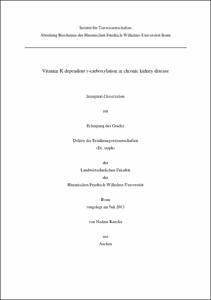Kaesler, Nadine: Vitamin K dependent γ-carboxylation in chronic kidney disease. - Bonn, 2014. - Dissertation, Rheinische Friedrich-Wilhelms-Universität Bonn.
Online-Ausgabe in bonndoc: https://nbn-resolving.org/urn:nbn:de:hbz:5n-34683
Online-Ausgabe in bonndoc: https://nbn-resolving.org/urn:nbn:de:hbz:5n-34683
@phdthesis{handle:20.500.11811/5820,
urn: https://nbn-resolving.org/urn:nbn:de:hbz:5n-34683,
author = {{Nadine Kaesler}},
title = {Vitamin K dependent γ-carboxylation in chronic kidney disease},
school = {Rheinische Friedrich-Wilhelms-Universität Bonn},
year = 2014,
month = jan,
note = {Vascular calcification is present in atherosclerosis, ageing, chronic kidney diseases and diabetes and is strongly associated with an increased morbidity and mortality. Calcification of arteries occurs at the tunica intima and the tunica media. Thereby, vascular smooth muscles cells (VSMC) transdifferentiate into an osteoblastic phenotype. Modifiable calcification inhibitors were identified of which matrix gla protein (MGP) is regarded as the most potent one being expressed in the vascular wall. MGP gets posttranslationally gamma carboxylated at 5 glutamic acid residues, which achieve calcium binding properties. This carboxylation step requires reduced vitamin K as a cofactor. It is provided and recycled in the so called vitamin K cycle, which consists of the vitamin K epoxide reductase (VKOR), DT-diaphorase and γ-glutamyl carboxylase (GGCX). The effects of uremia on vitamin K recycling via the vitamin K cycle are unknown. Besides MGP, other vitamin K dependent proteins are known. One is the Gas6 protein, which is also expressed by VSMC, but its role is not yet fully understood. Gas6 offers one n-terminal carboxylation site. Aim of this thesis was to characterize the activities of three enzymes of the vitamin K cycle and the role of vitamin K dependent Gas6 protein under uremic conditions.
First, a fluorescence method for the quantification of GGCX activity in vitro in tissue samples was developed. This method employs a fluorescein isothiocyanate (FITC) labelled Glu containing hexapeptide which gets carboxylated by the GGCX.
Second, the influences of uremia and pharmacological doses of vitamin K supplementation on the activity of the vitamin K cycle and extraosseous calcification were investigated. Uremia was induced in rats by adenine diet, in part supplemented with vitamin K1 or K2 for 4 or 7 weeks. The GGCX activity was decreased under uremic conditions possibly contributing to calcifications. The GGCX activity can be restored by vitamin K supplementation.
Third, the influence of Gas6 protein on vascular calcification was investigated in murine in vitro VSMC culture and different in vivo models using a) Warfarin diet, b) uninephrectomy or c) electrocautery of the kidney as well d) ageing mice. No differences were found in tissue calcium content, echocardiography and biochemical serum and urine parameter between Gas6-/- mice and wildtype controls. This does not support a role of Gas6 in the pathogenesis of vascular calcification.},
url = {https://hdl.handle.net/20.500.11811/5820}
}
urn: https://nbn-resolving.org/urn:nbn:de:hbz:5n-34683,
author = {{Nadine Kaesler}},
title = {Vitamin K dependent γ-carboxylation in chronic kidney disease},
school = {Rheinische Friedrich-Wilhelms-Universität Bonn},
year = 2014,
month = jan,
note = {Vascular calcification is present in atherosclerosis, ageing, chronic kidney diseases and diabetes and is strongly associated with an increased morbidity and mortality. Calcification of arteries occurs at the tunica intima and the tunica media. Thereby, vascular smooth muscles cells (VSMC) transdifferentiate into an osteoblastic phenotype. Modifiable calcification inhibitors were identified of which matrix gla protein (MGP) is regarded as the most potent one being expressed in the vascular wall. MGP gets posttranslationally gamma carboxylated at 5 glutamic acid residues, which achieve calcium binding properties. This carboxylation step requires reduced vitamin K as a cofactor. It is provided and recycled in the so called vitamin K cycle, which consists of the vitamin K epoxide reductase (VKOR), DT-diaphorase and γ-glutamyl carboxylase (GGCX). The effects of uremia on vitamin K recycling via the vitamin K cycle are unknown. Besides MGP, other vitamin K dependent proteins are known. One is the Gas6 protein, which is also expressed by VSMC, but its role is not yet fully understood. Gas6 offers one n-terminal carboxylation site. Aim of this thesis was to characterize the activities of three enzymes of the vitamin K cycle and the role of vitamin K dependent Gas6 protein under uremic conditions.
First, a fluorescence method for the quantification of GGCX activity in vitro in tissue samples was developed. This method employs a fluorescein isothiocyanate (FITC) labelled Glu containing hexapeptide which gets carboxylated by the GGCX.
Second, the influences of uremia and pharmacological doses of vitamin K supplementation on the activity of the vitamin K cycle and extraosseous calcification were investigated. Uremia was induced in rats by adenine diet, in part supplemented with vitamin K1 or K2 for 4 or 7 weeks. The GGCX activity was decreased under uremic conditions possibly contributing to calcifications. The GGCX activity can be restored by vitamin K supplementation.
Third, the influence of Gas6 protein on vascular calcification was investigated in murine in vitro VSMC culture and different in vivo models using a) Warfarin diet, b) uninephrectomy or c) electrocautery of the kidney as well d) ageing mice. No differences were found in tissue calcium content, echocardiography and biochemical serum and urine parameter between Gas6-/- mice and wildtype controls. This does not support a role of Gas6 in the pathogenesis of vascular calcification.},
url = {https://hdl.handle.net/20.500.11811/5820}
}






